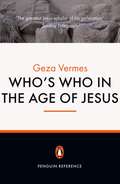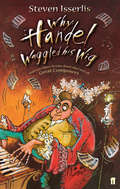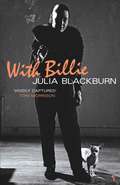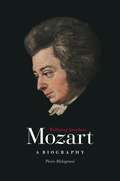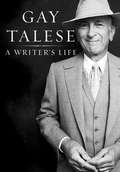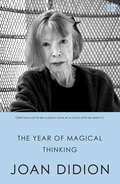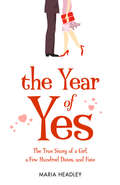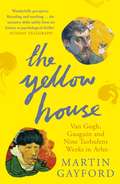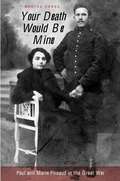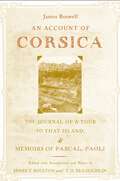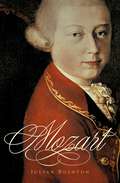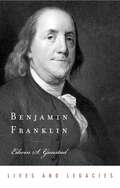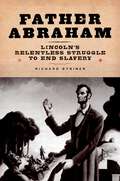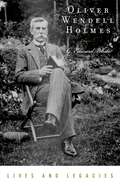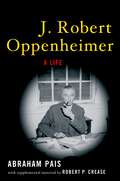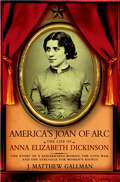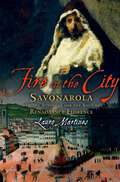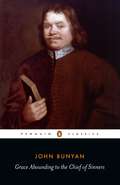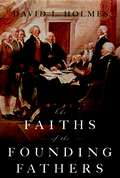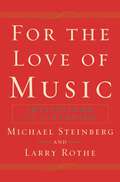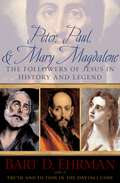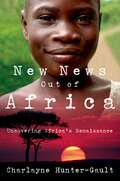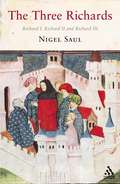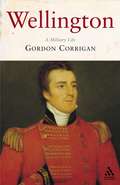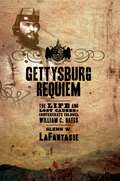- Table View
- List View
Who's Who in the Age of Jesus (Playaway Adult Nonfiction Ser.)
by Geza VermesThe books of the New Testament are some of the most extraordinary documents ever created - brilliant, vivid works central to the lives of many millions of readers over the centuries. Yet, the picture they give of Jesus' world is a very partial one. Written thirty to eighty years after the events they describe and with very specific doctrinal aims they addressed a Greek-speaking audience when Christianity was at its most precarious. Geza Vermes, one of the world's foremost biblical scholars, is uniquely positioned to guide the reader through the many conundrums presented by the New Testament. Who's Who in the Age of Jesus is an ambitious and enjoyable attempt to sift through all the sources for the period to create biographies of the major (and some fascinating minor) figures from Jesus' era. The book allows readers to understand a Jewish, Roman and Hellenistic world crowded with explosive, mutually antagonistic groups - a world which would give rise both to a new Judaism and ultimately to Christianity. From detailed, convincing portraits of Jesus, John the Baptist, Pontius Pilate, Herod and other key New Testament figures to the Jewish and Roman leaders like Hillel, Caiaphas, Augustus, Vespasian and Titus, hardly or not at all mentioned in the Gospels or the Acts of the Apostles, Geza Vermes' illustrated Who's Who will throw much fresh light on the age of Jesus and provoke innumerable arguments and discussions.
Why Handel Waggled His Wig: And Lots More Stories About The Lives Of Great Composers
by Steven IsserlisThe eagerly awaited follow-up to the best-selling Why Beethoven Threw the Stew.What did Haydn's wife use for curling-paper for her hair?What did Schubert do with his old spectacles case?Why was Dvorák given a butcher's apron when he was a little boy?Why did Tchaikovsky spit on a map of Europe?Why did Fauré find a plate of spinach on his face?And why did Handel waggle his wig?In Why Beethoven Threw the Stew, renowned cellist Steven Isserlis set out to pass on to children a wonderful gift given to him by his own cello teacher - the chance to people his own world with the great composers by getting to know them as friends. In his new book he draws us irresistibly into the world of six more favourite composers, bringing them alive in a manner that cannot fail to catch the imagination of children encountering classical music for the first time. Once again the text is packed with facts, dates and anecdotes, interspersed with lively black-and-white line illustrations, making this an attractive and accessible read for children to enjoy on their own or share with an adult.'If Why Beethoven Threw the Stew does not turn your child into a music lover, the chances are nothing will.' Daily Mail
With Billie: A New Look At The Unforgettable Lady Day
by Julia BlackburnJulia Blackburn's brilliant and haunting book is a life of Billie Holiday told in the voices of those who knew her. During the 1970s a young woman called Linda Kuehl, planning to write a biography of Billie, recorded interviews with more than 150 people. Kuehl died in 1978 and her book never came out, but her recordings survived to provide the raw material for this extraordinary account of the life of America's First Lady of Jazz.Billie Holiday is usually portrayed as a tragic victim of her own vices. These intimate stories give us a much deeper picture of her personality - we witness scenes from her chaotic childhood; we see her when she first arrives in Harlem at the age of fourteen; and we follow her through her rise to fame and into the notoriety that came so close on its heels. Billie's friends and lovers and fellow musicians talk about her troubles and her addictions, but they also have a lot to say about her warmth and her courage, and the ones who were really close to her understood that although she had a lot of men and drugs and booze in her life, all that really mattered was the singing.
Wolfgang Amadeus Mozart: A Biography
by Piero MelograniThis year marks the 250th anniversary of the birth of Wolfgang Amadeus Mozart, one of the most enduringly popular and celebrated composers to have ever lived. His substantial oeuvre contains works that are considered to be among the most exquisite pieces of symphonic, chamber, and choral music ever written. His operas too cast a long shadow over those staged in their wake. And since his untimely death in 1791, he remains an enigmatic figure—the subject of fascination for aficionados and novices alike. Piero Melograni here offers a wholly readable account of Mozart’s remarkable life and times. This masterful biography proceeds from the young Mozart’s earliest years as a Wunderkind—the child prodigy who traveled with his family to perform concerts throughout Europe—to his formative years in Vienna, where he fully absorbed the artistic and intellectual spirit of the Enlightenment, to his deathbed, his unfinished Requiem, and the mystery that still surrounds his burial. Melograni’s deft use of Mozart’s letters throughout confers authority and vitality to his recounting, and his expertise brings Mozart’s eighteenth-century milieu evocatively to life. Written with a gifted historian’s flair for narrative and unencumbered by specialized analyses of Mozart’s music, Melograni’s is the most vivid and enjoyable biography available. At a time when music lovers around the world are paying honor to Mozart and his legacy, Wolfgang Amadeus Mozart will be welcomed by his enthusiasts—or anyone wishing to peer into the mind of one of the greatest composers ever known.
A Writer's Life
by Gay TaleseHow has Gay Talese found his subjects? How has he gotten them onto the page? What drives him to write? These are some of the questions at the heart of the narrative that combines memory, reflection, explanation and a satisfying obsession. I his trademark prose - precise, beautifully crafted, elegant - Talese traces the paths his passionate interests have made through his life and writing. He talks about first becoming absorbed in issues of race as a student in Alabama, about covering the civil rights struggle and about a recent interracial wedding in Selma. He reflects on the changing American sexual mores he has written about over the last 50 years, and gives an incisive examination of the lives of Lorena and John Bobbitt. He talks about his legendary Esquire profile of Frank Sinatra - judged by the magazine to be the finest in its long history - and about the ordinary men and women whose stories led to some of his most memorable work. And as he delves into the life of a young female Chinese soccer player, we see his consuming interest in the world in its latest manifestation. In these and other recollections and stories, he gives us a fascinating picture of both the serendipity and meticulousness involved in getting a story, and getting it right.Candid, humorous, deeply impassioned - a dazzling book about the nature of writing in one man's life, and of writing itself.
The Year of Magical Thinking (Sparknotes Literature Guide Ser.)
by null Joan DidionFrom one of America's iconic writers, a portrait of a marriage and a life – in good times and bad – that will speak to anyone who has ever loved a husband or wife or child. A stunning book of electric honesty and passion. Several days before Christmas 2003, John Gregory Dunne and Joan Didion saw their only daughter, Quintana, fall ill. At first they thought it was flu, then pneumonia, then complete sceptic shock. She was put into an induced coma and placed on life support. Days later – the night before New Year’s Eve –the Dunnes were just sitting down to dinner after visiting the hospital when John suffered a massive and fatal coronary. In a second, this close, symbiotic partnership of 40 years was over. Four weeks later, their daughter pulled through. Two months after that, arriving at LA airport, she collapsed and underwent six hours of brain surgery at UCLA Medical Centre to relieve a massive hematoma. This powerful book is Didion’s ‘attempt to make sense of the weeks and then months that cut loose any fixed idea I ever had about death, about illness … about marriage and children and memory … about the shallowness of sanity, about life itself’. The result is an exploration of an intensely personal yet universal experience: a portrait of a marriage, and a life, in good times and bad.
The Year of Yes: The Story Of A Girl, A Few Hundred Dates, And Fate
by Maria HeadleyHeadley, a wise-cracking New York City girl with as much wit as any character on Sex and the City, is jaded and cynical about men in New York. She vows to say yes to any and every person who asks her out – a taxi driver, a homeless man – you name it, she'll say yes for an entire year. By the year's end, she meets the man she eventually marries.
The Yellow House: Van Gogh, Gauguin, and Nine Turbulent Weeks in Arles
by Martin GayfordTwo artistic giants. One small house. From October to December 1888 a pair of largely unknown artists lived under one roof in the French provincial town of Arles. Paul Gauguin and Vincent Van Gogh ate, drank, talked, argued, slept and painted in one of the most intense and astonishing creative outpourings in history. Yet as the weeks passed Van Gogh buckled under the strain, fought with his companion and committed an act of violence on himself that prompted Gauguin to flee without saying goodbye to his friend. The Yellow House is an intimate portrait of their time together as well as a subtle exploration of a fragile friendship, art, madness, genius and the shocking act of self-mutilation that the world has sought to explain ever since.
Your Death Would Be Mine: Paul and Marie Pireaud in the Great War
by Martha HannaPaul and Marie Pireaud, a young peasant couple from southwest France, were newlyweds when World War I erupted. With Paul in the army from 1914 through 1919, they were forced to conduct their marriage mostly by correspondence. Drawing upon the hundreds of letters they wrote, Martha Hanna tells their moving story and reveals a powerful and personal perspective on war. Civilians and combatants alike maintained bonds of emotional commitment and suffered the inevitable miseries of extended absence. While under direct fire at Verdun, Paul wrote with equal intensity and poetic clarity of the brutality of battle and the dietary needs (as he understood them) of his pregnant wife. Marie, in turn, described the difficulties of working the family farm and caring for a sick infant, lamented the deaths of local men, and longed for the safe return of her husband. Through intimate avowals and careful observations, their letters reveal how war transformed their lives, reinforced their love, and permanently altered the character of rural France. Overwhelmed by one of the most tumultuous upheavals of the modern age, Paul and Marie found solace in family and strength in passion. Theirs is a human story of loneliness and longing, fear in the face of death, and the consolations of love. Your Death Would Be Mine is a poignant tale of ordinary people coping with the trauma of war.
An Account of Corsica, the Journal of a Tour to That Island; and Memoirs of Pascal Paoli
by James BoswellThis first complete reprint of Boswell's book on Corsica since the eighteenth century is enhanced by comprehensive annotation, textual apparatus, and a critical introduction. Boswell designed his text in two parts: first, an Account of Corsica, which gives a historical, political, socio-economic, and cultural overview of the Corsican people, and second, the Journal of his tour to see the Corsican leader Pascal Paoli in 1765. This edition, unlike so many reprints of just the Journal, allows the reader to appreciate Boswell's original design. The young and adventuresome Boswell wanted to write a book that would swing public opinion, and perhaps the British government, to support the Corsicans in their struggle for independence. He was well aware that his English readers had but the haziest ideas about Corsica gleaned from but snatches of news in the papers. The first part would therefore provide the context within which to understand and appreciate his account of his journey to and meeting with Paoli. The complete text also illustrates aspects of Boswell that have received less attention than they might, namely, his sense of history, his political enthusiasm for national liberty, and his scholarship. He brings to the book a solid foundation in the Classics and the law, a facility in French and Italian, and a sensitivity to writing that, as the notes show, is evident in the reworking of his manuscript. The editors' introduction and the extensive annotation point up Boswell the scholar--assiduous, sedulous to get at the relevant sources, careful to do justice to those he disagreed with, and open about seeking and acknowledging advice. The text reveals Boswell as a serious and independent thinker and a writer committed to Corsica's independence. What he argued for and presumed was about to be achieved is still a matter of debate in Corsica and metropolitan France.
Mozart (Master Musicians Series)
by Julian RushtonWolfgang Amadeus Mozart is one of the great icons of Western music. An amazing prodigy--he toured the capitals of Europe while still a child, astonishing royalty and professional musicians with his precocious skills--he wrote as an adult some of the finest music in the entire European tradition. Julian Rushton offers a concise and up-to-date biography of this musical genius, combining a well-researched life of the composer with an introduction to the works--symphonic, chamber, sacred, and theatrical--of one of the few musicians in history to have written undisputed masterpieces across every genre of his time. Rushton offers a vivid portrait of the composer, ranging from Mozart the Wunderkind--travelling with his family from Salzburg to Vienna, Paris, London, Rome, and Milan--to the mature author of such classic works as "The Marriage of Figaro", "Don Giovanni", and "The Magic Flute". During the past half-century, scholars have thoroughly explored Mozart's life and music, offering new interpretations of his compositions based on their historical context and providing a factual basis for confirming or, more often, debunking fanciful accounts of the man and his work. Rushton takes full advantage of these biographical and musical studies as well as the definitive New Mozart Edition to provide an accurate account of Mozart's life and, equally important, an insightful look at the music itself, complete with musical examples. An engaging biography for general readers that will also be an informative resource for scholars, this new addition to the prestigious Master Musicians series offers an authoritative portrait of one of the defining figures of European culture.
Benjamin Franklin (Lives and Legacies Series)
by Edwin S. GaustadThe tenth and youngest son of a poor Boston soapmaker, Benjamin Franklin would rise to become, in Thomas Jefferson's words, "the greatest man and ornament of his age." In this short, engaging biography, historian Edwin S. Gaustad offers a marvelous portrait of this towering colonial figure, illuminating Franklin's character and personality. Here is truly one of the most extraordinary lives imaginable, a man who, with only two years of formal education, became a printer, publisher, postmaster, philosopher, world-class scientist and inventor, statesman, musician, and abolitionist. Gaustad presents a chronological account of all these accomplishments, delightfully spiced with quotations from Franklin's own extensive writings. The book describes how the hardworking Franklin became at age 24 the most successful printer in Pennsylvania and how by 42, with the help of Poor Richard's Almanack, he had amassed enough wealth to retire from business. We then follow Franklin's next brilliant career, as an inventor and scientist, examining his pioneering work on electricity and his inventions of the Franklin Stove, the lightning rod, and bifocals, as well as his mapping of the Gulf Stream, a major contribution to navigation. Lastly, the book covers Franklin's role as America's leading statesman, ranging from his years in England before the Revolutionary War to his time in France thereafter, highlighting his many contributions to the cause of liberty. Along the way, Gaustad sheds light on Franklin's personal life, including his troubled relationship with his illegitimate son William, who remained a Loyalist during the Revolution, and Franklin's thoughts on such topics as religion and morality. Written by a leading authority on colonial America, this compact biography captures in a remarkably small space one of the most protean lives in our nation's history.
Father Abraham: Lincoln's Relentless Struggle to End Slavery
by Richard StrinerLincoln is the single most compelling figure in our history, but also one of the most enigmatic. Was he the Great Emancipator, a man of deep convictions who ended slavery in the United States, or simply a reluctant politician compelled by the force of events to free the slaves? In Father Abraham, Richard Striner offers a fresh portrait of Lincoln, one that helps us make sense of his many contradictions. Striner shows first that, if you examine the speeches that Lincoln made in the 1850s, you will have no doubt of his passion to end slavery. These speeches illuminate the anger, vehemence, and sheer brilliance of candidate Lincoln, who worked up crowds with charismatic fervor as he gathered a national following. But if he felt so passionately about abolition, why did he wait so long to release the Emancipation Proclamation? As Striner points out, politics is the art of the possible, and Lincoln was a consummate politician, a shrewd manipulator who cloaked his visionary ethics in the more pragmatic garb of the coalition-builder. He was at bottom a Machiavellian prince for a democratic age. When secession began, Lincoln used the battle cry of saving the Union to build a power base, one that would eventually break the slave-holding states forever. Striner argues that Lincoln was a rare man indeed: a fervent idealist and a crafty politician with a remarkable gift for strategy. It was the harmonious blend of these two qualities, Striner concludes, that made Lincoln's role in ending slavery so fundamental.
Oliver Wendell Holmes Jr. (Lives and Legacies Series)
by G. Edward WhiteKnown as the "Great Dissenter," Oliver Wendell Holmes, Jr. wrote some of the most eloquent opinions in the history of the United States Supreme Court. A brilliant legal mind who served on the high court into his nineties, Holmes was responsible for some of the most important judicial opinions of the twentieth century. Now, in this superb short biography, G. Edward White offers readers a lively, informative portrait of this singular individual. The book first sketches Holmes's early years--his childhood in Boston, his undergraduate years at Harvard (which his father and both grandfathers also attended), and his valiant service in the Civil War, during which he was severely wounded three times. After the war, Holmes went into private law practice, wrote his landmark treatise The Common Law in 1881, had a short tenure on the Harvard Law School faculty, and spent 20 years as a judge on the Supreme Judicial Court of Massachusetts before being named to the U.S. Supreme Court. The author focuses on his remarkable 30-year service as a Supreme Court Justice, beginning in 1902, and details Holmes's most significant cases--Abrams v. United States, Northern Securities Co. v. United States, Lochner v. New York, Schenck v. United States, and others--which limited working hours, set a mandatory minimum wage, protected women's rights, legalized labor unions, and defined freedom of speech. These decisions--as well as The Common Law--are highly regarded to this day. A new volume in the Lives and Legacy series, this marvelous short biography offers an ideal introduction to a towering figure in American law.
J. Robert Oppenheimer: A Life
by the late Abraham PaisThe late Abraham Pais, author of the award winning biography of Albert Einstein, Subtle is the Lord, here offers an illuminating portrait of another of his eminent colleagues, J. Robert Oppenheimer, one of the most charismatic and enigmatic figures of modern physics. Pais introduces us to a precocious youth who sped through Harvard in three years, made signal contributions to quantum mechanics while in his twenties, and was instrumental in the growth of American physics in the decade before the Second World War, almost single-handedly bringing it to a state of prominence. He paints a revealing portrait of Oppenheimer's life in Los Alamos, where in twenty remarkable, feverish months, and under his inspired guidance, the first atomic bomb was designed and built, a success that made Oppenheimer America's most famous scientist. Pais describes Oppenheimer's long tenure as Director of the Institute of Advanced Study at Princeton, where the two men worked together closely. He shows not only Oppenheimer's brilliance and leadership, but also how his displays of intensity and arrogance won him powerful enemies, ones who would ultimately make him one of the principal victims of the Red Scare of the 1950s. J. Robert Oppenheimer is Abraham Pais's final work, completed after his death by Robert P. Crease, an acclaimed historian of science in his own right. Told with compassion and deep insight, it is the most comprehensive biography of the great physicist available. Anyone seeking an insider's portrait of this enigmatic man will find it indispensable.
America's Joan of Arc: The Life of Anna Elizabeth Dickinson
by J. Matthew GallmanOne of the most celebrated women of her time, a spellbinding speaker dubbed the Queen of the Lyceum and America's Joan of Arc, Anna Elizabeth Dickinson was a charismatic orator, writer, and actress, who rose to fame during the Civil War and remained in the public eye for the next three decades. J. Matthew Gallman offers the first full-length biography of Dickinson to appear in over half a century. Gallman describes how Dickinson's passionate patriotism and fiery style, coupled with her unabashed abolitionism and biting critiques of antiwar Democrats--known as Copperheads--struck a nerve with her audiences. In barely two years, she rose from an unknown young Philadelphia radical, to a successful New England stump speaker, to a true national celebrity. At the height of her fame, Dickinson counted many of the nation's leading reformers, authors, politicians, and actors among her friends. Among the dozens of famous figures who populate the narrative are Susan B. Anthony, Whitelaw Reid, William Lloyd Garrison, Frederick Douglass, Elizabeth Cady Stanton, and Harriet Beecher Stowe. Gallman shows how Dickinson's life illuminates the possibilities and barriers faced by nineteenth-century women, revealing how their behavior could at once be seen as worthy, highly valued, shocking, and deviant.
Fire in the City: Savonarola and the Struggle for the Soul of Renaissance Florence
by Lauro MartinesA gripping and beautifully written narrative that reads like a novel, Fire in the City presents a compelling account of a key moment in the history of the Renaissance, illuminating the remarkable man who dominated the period, the charismatic Girolamo Savonarola. Lauro Martines, whose decades of scholarship have made him one of the most admired historians of Renaissance Italy, here provides a remarkably fresh perspective on Savonarola, the preacher and agitator who flamed like a comet through late fifteenth-century Florence. The Dominican friar has long been portrayed as a dour, puritanical demagogue who urged his followers to burn their worldly goods in "the bonfire of the vanities." But as Martines shows, this is a caricature of the truth--the version propagated by the wealthy and powerful who feared the political reforms he represented. Here, Savonarola emerges as a complex and subtle man, both a religious and a civic leader--who inspired an outpouring of political debate in a city newly freed from the tyranny of the Medici. In the end, the volatile passions he unleashed--and the powerful families he threatened--sent the friar to his own fiery death. But the fusion of morality and politics that he represented would leave a lasting mark on Renaissance Florence. For the many readers fascinated by histories of Renaissance Italy--such as Brunelleschi's Dome or Galileo's Daughter, and Martines's acclaimed April Blood--Fire in the City offers a vivid portrait of one of the most memorable characters from that dazzling era.
Grace Abounding to the Chief of Sinners: A Brief And Faithful Relation Of The Exceeding Mercy Of God In Christ To His Poor Servant, John Bunyan
by John Bunyan W. OwensComposed and published while John Bunyan (1628-1688) was in prison for his religious principles, Grace Abounding is an extraordinary spiritual autobiography. It was written in an age when religious radicalism was regarded as socially subversive, and is a haunting, often harrowing and ultimately inspiring account of his inner life: his long struggle with and eventual triumph over doubt and despair, his spiritual regeneration and his subsequent emergence as a preacher and writer of great imaginative power. God and Satan are the chief protagonists in Bunyan's drama, existing not as theological concepts but as terrifyingly immediate adversaries in the competition for his soul. Yet he finds his spiritual defences in the Bible, and Grace Abounding charts his passionate and imaginative involvement with this ultimate source of wisdom.
The Faiths of the Founding Fathers
by David L. HolmesIt is not uncommon to hear Christians argue that America was founded as a Christian nation. But how true is this claim? In this compact book, David L. Holmes offers a clear, concise and illuminating look at the spiritual beliefs of our founding fathers. He begins with an informative account of the religious culture of the late colonial era, surveying the religious groups in each colony. In particular, he sheds light on the various forms of Deism that flourished in America, highlighting the profound influence this intellectual movement had on the founding generation. Holmes then examines the individual beliefs of a variety of men and women who loom large in our national history. He finds that some, like Martha Washington, Samuel Adams, John Jay, Patrick Henry, and Thomas Jefferson's daughters, held orthodox Christian views. But many of the most influential figures, including Benjamin Franklin, George Washington, John and Abigail Adams, Jefferson, James and Dolley Madison, and James Monroe, were believers of a different stripe. Respectful of Christianity, they admired the ethics of Jesus, and believed that religion could play a beneficial role in society. But they tended to deny the divinity of Christ, and a few seem to have been agnostic about the very existence of God. Although the founding fathers were religious men, Holmes shows that it was a faith quite unlike the Christianity of today's evangelicals. Holmes concludes by examining the role of religion in the lives of the presidents since World War II and by reflecting on the evangelical resurgence that helped fuel the reelection of George W. Bush. An intriguing look at a neglected aspect of our history, the book will appeal to American history buffs as well as to anyone concerned about the role of religion in American culture.
For The Love of Music: Invitations to Listening
by Michael Steinberg Larry RotheThe power of music, the way it works on the mind and heart, remains an enticing mystery. Now two noted writers on classical music, Michael Steinberg and Larry Rothe, explore the allure of this melodious art--not in the clinical terms of social scientists--but through stories drawn from their own experience. In For the Love of Music, Steinberg and Rothe draw on a lifetime of listening to, living with, and writing about music, sharing the delights and revelatory encounters they have had with Mozart, Brahms, Stravinsky, and a host of other great (and almost-great) composers. At once highly personal and immediately accessible, their writings shed light on those who make music and those who listen to it--drawing readers into the beautiful and dangerous terrain that has meant so much to the authors. In recounting how they themselves came to love music, Steinberg and Rothe offer keys for listening. You will meet the man who created the sound of Hollywood's Golden Age and you will learn how composers have addressed issues as contemporary as AIDS and the terrorist attacks of September 11.
Peter, Paul and Mary Magdalene: The Followers of Jesus in History and Legend
by Bart D EhrmanBart Ehrman, author of the highly popular books Truth and Fiction in The Da Vinci Code, Lost Christianities, and the New York Times bestseller Misquoting Jesus, here takes readers on another engaging tour of the early Christian church, illuminating the lives of Jesus' most intriguing followers: Simon Peter, the Apostle Paul, and Mary Magdalene. What does the Bible tell us about each of these key followers of Christ? What legends have sprung up about them in the centuries after their deaths? Was Paul bow-legged and bald? Was Peter crucified upside down? Was Mary Magdalene a prostitute? In this lively work, Ehrman separates fact from fiction, presenting complicated historical issues in a clear and informative way and relating vivid anecdotes culled from the traditions of these three followers. He notes, for instance, that there is no evidence to suggest that Mary Magdalene was a prostitute (this legend can be traced to a sermon preached by Gregory the Great five centuries after her death), and little reason to think that she was married to Jesus. Similarly, there is no historical evidence for the well-known tale that Peter was crucified upside down. A serious book but vibrantly written and leavened with many colorful stories, Peter, Paul, and Mary Magdalene will appeal to anyone curious about the early Christian church and the lives of these important figures. "An informed but breezy look at the myths surrounding Jesus' most influential followers.... This book contains valuable historical scholarship. It also encourages readers to approach the Scriptures with fresh and enlightened eyes." --Christian Science Monitor
New News Out of Africa: Uncovering Africa's Renaissance
by Charlayne Hunter-GaultFor twenty years an acclaimed correspondent on PBS's The News Hour with Jim Lehrer and the winner of two Emmys and two Peabody Awards (the latter two for her coverage of Africa), Charlayne Hunter-Gault was until recently the Johannesburg Bureau Chief for CNN. In New News Out of Africa, this eminent reporter offers a fresh and surprisingly optimistic assessment of modern Africa, revealing that there is more to the continent than the bad news of disease, disaster, and despair. Blending personal memoir with sterling reportage and astute analysis, Hunter Gault presents an Africa we rarely see. She looks first at South Africa, contrasting the country she first encountered as a young reporter--when she personally witnessed the brutality of apartheid--with the black-led, multiracial society of today, a nation undergoing one of the most radical social and economic experiments in modern times. She acknowledges the great imbalance in income in modern South Africa (where upwards of 30 to 40 percent of blacks are unemployed) and describes the ravaging effect of AIDS on the nation, but she also underscores the nation's commitment to affirmative action, describes how South African universities have opened their doors to black students, and debunks many of the myths about the violence of South African society. Likewise, Hunter-Gault looks at the continent-wide efforts to promote "an African Renaissance," illuminating the political and economic conditions in Rwanda, Mozambique, Nigeria, Ghana, Kenya, Angola, and Sierra Leone. Finally, the book describes the challenges of reporting on the much-maligned continent and the efforts of African journalists to tell their own story. A compelling book on a topic of vital importance, New News Out of Africa promises to re-define what is news about this vast and complex continent.
The Three Richards: Richard I, Richard II and Richard III
by Nigel SaulThe three Richards who ruled England in the Middle Ages were among the most controversial and celebrated of its rulers. Richard I ('Coeur de Lion', 1189-99) was a great crusading hero; Richard II (1377-99) was an authoritarian aesthete deposed by his cousin, Henry IV, and murdered; while Richard III (1483-85), as the murderer of his nephews, 'The Princes in the Tower', was the most notorious villain in English history. This highly readable joint biography shows how much the three kings had in common, apart from their names. All were younger sons of monarchs, not expected to come to the throne; all failed to leave a legitimate heir, causing instability on their deaths; all were cultured and pious; and all died violently. All have attracted accusations but also fascination. In comparing them, Nigel Saul tells three gripping stories and shows what it took to be a medieval king.
Wellington: A Military Life
by Gordon CorriganThe Duke of Wellington, the most successful of British commanders, set a standard by which all subsequent British generals have been measured. His defeat of Napoleon at Waterloo in 1815 crowned a reputation first won in India at Assaye and then confirmed during the Peninsular War, where he followed up his defence of Portugal by expelling the French from Spain. Gordon Corrigan, himself an ex-soldier, examines his claims to greatness. Wellington was in many ways the first modern general, combining a mastery of logistics with an ability to communicate and inspire. He had to contend not only with enemy armies but also with his political masters and an often sceptical public at home.
Gettysburg Requiem: The Life and Lost Causes of Confederate Colonel William C. Oates
by Glenn W. LaFantasieWilliam C. Oates is best remembered as the Confederate officer defeated at Gettysburg's Little Round Top, losing a golden opportunity to turn the Union's flank and win the battle--and perhaps the war. Now, Glenn W. LaFantasie--bestselling author of Twilight at Little Round Top--has written a gripping biography of Oates. Oates was no moonlight-and-magnolias Southerner, as LaFantasie shows. Raised in the hard-scrabble Wiregrass Country of Alabama, he ran away from home as a teenager, roamed through Louisiana and Texas--where he took up card sharking--and finally returned to Alabama, to pull himself up by his bootstraps and become a respected attorney. During the war, he rose to the rank of colonel, served under Stonewall Jackson and Lee, was wounded six times and lost an arm. Returning home, he launched a successful political career, becoming a seven-term congressman and ultimately governor. LaFantasie shows how, for Oates, the war never really ended--he remained devoted to the Lost Cause, and spent the rest of his life waging the political battles of Reconstruction. Here then is a richly evocative story of Southern life before, during, and after the Civil War, based on first-time and exclusive access of family papers and never-before-seen archives.
